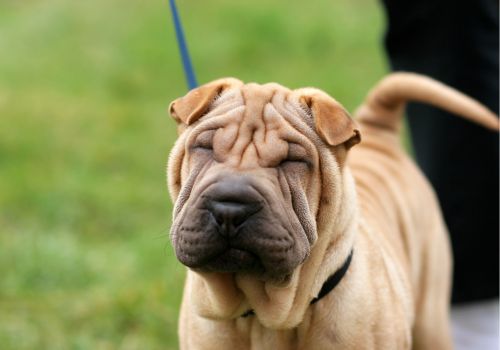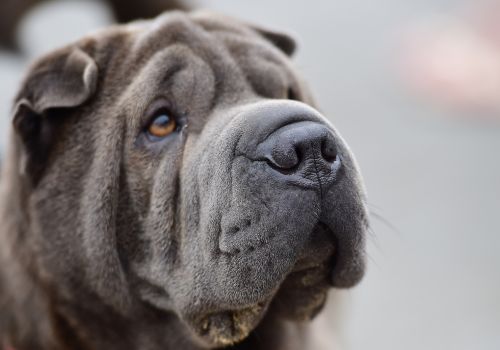Known for their iconic deep wrinkles and watchful eyes, Chinese Shar-Peis are a fascinating mix of loyalty and independence. So, if you've ever been intrigued by this ancient, dignified breed, read on!
Qualities You'll Cherish:
- Quiet Companion: Shar-Peis are generally quiet dogs, so if you prefer a less vocal pet, this could be the breed for you.
- Self-Reliant: These dogs are confident and can entertain themselves, offering you the best of both companionship and independence.
- Family Guardian: Protective by nature, they make excellent watchdogs, always alert and ready to defend their family.
- Loyal and Devoted: They may be reserved, but they are extremely loyal to those they trust.
- Highly Trainable: Their intelligence makes them relatively easy to train, as long as you provide strong leadership.
The Wrinkles of Responsibility: Challenges You Might Encounter
- Strong-Willed: They have an independent streak and will need a firm leader to guide them.
- Noisy Breathing: Expect to hear various snorts, wheezes, and even some snoring.
- Territorial Nature: They can be territorial around other animals, so early socialization is necessary.
- Overprotective: Without proper socialization, they can become overprotective and standoffish, especially around strangers.

Ancient Roots: A Breed Steeped in History
The Chinese Shar-Pei hails from China and has been a multipurpose breed used for guarding, fighting, and farm work. One of their most notable features is their blue-black tongue, something they share with the Chow Chow.
Grooming and Health
Despite their wrinkled appearance, Shar-Peis actually have low grooming needs. However, they are prone to certain health conditions like allergies, eye problems, and knee issues. Regular veterinary check-ups are crucial for early detection and a long, happy life.
Conclusion
The Chinese Shar-Pei is a unique blend of independence and loyalty, requiring a strong leader who appreciates their dignified nature. If you can navigate the challenges and embrace their protective traits, you'll find a devoted and intelligent companion in the Shar-Pei. Given their territorial nature, a securely fenced yard is almost non-negotiable for this breed.

Genetic Predispositions for Chinese Shar-Peis
Bloat: The Swift and Silent Threat to Your Shar-Pei
Ah, the Shar-Pei, a breed so unique and adorable with its wrinkly skin and compact frame. But did you know this breed is more at risk for a condition known as Bloat, or Gastric Dilatation and Volvulus (GDV)- more informally known as bloat? This stomach-twisting ordeal can cut off blood supply and become fatal within just 30 minutes if left untreated. Common signs include an enlarged abdomen, restlessness, and unproductive retching. If you spot these symptoms, it's straight to the emergency room for your pup. Prevention can include a surgery that tacks the stomach in place, lessening the chances of a twist. So, keep those vet contacts handy!
Allergies: Why Your Shar-Pei Might Be Itchy All Over
People sneeze, dogs itch—especially Shar-Peis. Called “atopy,” this skin allergy usually shows up between ages one and three. Affected areas often include the belly, feet, skin folds, and ears. If you notice your Shar-Pei frequently licking their paws or rubbing their face, allergies could be the culprit. The great news? There are several treatment options to make your pooch more comfortable, so it's far from a life sentence of itchiness!
Eyeing The Issue: Common Eye Problems in Shar-Peis

Your Shar-Pei's eyes aren't just soulful; they're also vulnerable to several conditions that can severely affect their quality of life. Glaucoma is a particularly painful one that can lead to blindness. Its symptoms—like squinting and watery eyes—are medical emergencies, so if you spot these, rush to the vet. Then there's ' cherry eye', a condition common in younger Shar-Peis that might require surgery, and 'Entropion', where the eyelid rolls inward. All of these are good reasons to make regular eye exams part of your pet care routine.
Kneesy Does It: Patellar Luxation in Shar-Peis
Ever notice your Shar-Pei hop and skip during a run? They might be dealing with patellar luxation, a condition where the kneecap slips out of place. While mild cases might just need arthritis medication, severe ones could require surgical intervention to keep that kneecap where it should be.
Joints and Pains: Hip and Elbow Dysplasia
If your Shar-Pei seems stiff or struggles to get up, it might be hip or elbow dysplasia. This inherited condition can make your pooch's golden years less comfortable, but early detection through X-rays and prompt treatment can minimize the pain. Remember, an overweight dog is more likely to suffer, so keep an eye on that diet!
Amyloidosis: More Than Just a Protein Problem
Shar-Peis are at a greater risk of developing amyloidosis, a condition where misfolded proteins accumulate in places they shouldn't. In dogs, this can lead to kidney, liver, adrenal gland, or pancreatic disease. If you notice symptoms like vomiting, weight loss, or poor appetite, a vet visit is in order. While there's no cure, symptomatic treatment can improve your pet’s quality of life.
Mast Cell Tumor: The Tricky Skin Cancer
Sadly, Chinese Shar-Peis are more susceptible to mast cell tumors. These nasty skin cancers often look like regular lumps, making them deceptive and dangerous. If you find any new lump or bump on your pup, get it tested ASAP. Early surgical removal is your best bet.
Megaesophagus: When Eating Becomes a Struggle
Megesophagus may sound like a dinosaur, but it's actually a condition where your Shar-Pei's esophagus loses its groove, making it difficult for food to pass to the stomach. If your dog throws up undigested, tube-shaped food, it’s time for an x-ray to confirm the diagnosis. Management includes special feeding techniques and possibly medication. Take quick action if you notice something off, as this condition can lead to severe pneumonia.
Inflammatory Bowel Disease: More Than Just a Tummy Ache
Inflammatory Bowel Disease ( IBD) is more than just an occasional bellyache; it's a chronic condition that Shar-Peis are unfortunately prone to. Imagine the lining of your pup's intestines being constantly stormed by immune cells, leading to chronic vomiting and diarrhea. The issue isn't just discomfort; it messes with nutrient absorption, affecting your pet's overall health. Stress, diet changes, or even parasites can exacerbate the condition. If tummy troubles become a regular affair for your Shar-Pei, consult your vet for diagnostic tests, which could include an intestinal biopsy. Most of the time, this condition will require special diets and lifelong medication.

Mange: When Mites Outstay Their Welcome
All dogs have microscopic mites called Demodex living in their hair follicles. Usually, it's no big deal—but in Shar-Peis, these mites can multiply like they're having a party! This can result in dry, hairless patches that might appear on the face or feet. Sometimes these patches can get itchy and even lead to secondary skin infections. Quick veterinary action is essential to manage this problem. Some dogs grow out of it, while others need ongoing care.
The Breathing Battle: Respiratory Distress Syndrome
Respiratory Distress Syndrome or brachycephalic syndrome could make your Shar-Pei feel like he's breathing through a straw. Because of their short noses, these adorable pups can have obstructed airways, leading to symptoms like loud breathing, coughing, and even fainting. The condition can be so severe that some dogs struggle to breathe! If you notice any of these signs, consult your vet right away. In severe cases, surgery could be the way forward.
Skin Disease: Flaky vs Oily, But Always Itchy
Seborrhea can either make your Shar-Pei's skin dry and flaky or greasy and oily. Either way, it's uncomfortable and itchy for your pup. Conditions like hypothyroidism or even allergies can trigger seborrhea. Consult your vet for targeted treatment to get that coat back to its shiny, healthy self.
Bone Pain: Growing Pains Aren't Always Cute
Growing up is hard, especially when your Shar-Pei experiences eosinophilic panosteitis or "pano." This condition inflames the long bones in the legs, causing painful symptoms that can jump from one leg to another. While usually not causing permanent damage, it does require pain management and possibly rehabilitation exercises.
Skin Infections: Folded But Not Flawless
One of the charming features of a Shar-Pei is their wrinkled skin. However, these folds can trap moisture and create a breeding ground for bacteria and yeast, leading to a condition known as lip-fold pyoderma. It causes red, smelly patches that are far from comfortable for your fur baby. Regular cleaning and, in severe cases, antibiotics or even surgical intervention may be necessary.
Nutrient Malabsorption: The B12 Battle
You know how we need Vitamin B12 for energy? Well, some Shar-Peis have a genetic defect that hampers their ability to absorb this essential nutrient, leading to a host of problems like stunted growth and low blood cell counts. But don't worry! Blood tests can identify this rare condition. If diagnosed, your dog will need B12 injections for life, but that's a small price for a healthy, happy pup!
If you have questions and you'd like to reach out to us, you can call us directly at (518) 620-5154, or you can email us at [email protected]. Don't forget to follow us on social media Facebook, Instagram.
